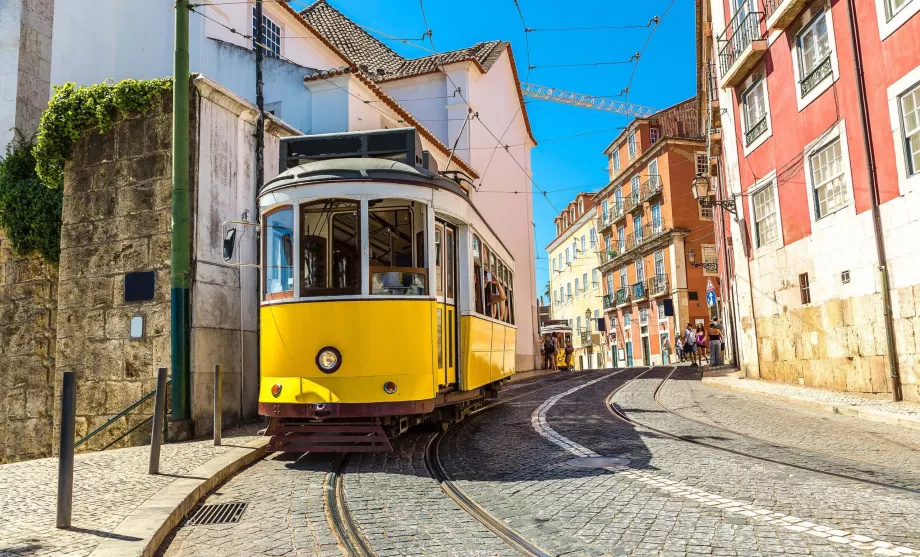What to do in Lisbon

Lisbon is one of the most photogenic and diverse cities in Europe.
Stroll through the narrow streets of the centre, spread over many hills, experience the atmosphere of the local bars and restaurants, where you can listen to the melancholy melodies of fado and take a trip outside Lisbon to the ocean or other historic towns.
How much do hotels in Lisbon cost? Find out on booking.com now
City views
Thanks to the terrain around the city, you'll find several viewpoints (miradouro) and Lisbon is one of the most beautiful cities in Europe in this respect.
Where to go for the best views in Lisbon?
Some of the most beautiful and famous ones include:
- Miradouro da Nossa Senhora do Monte - ideal for sunsets (google.com/maps)
- Miradouro Padrao dos Descobrimentos - a view from the embankment by the Tejo River of the 25th of April Bridge or the Christ Statue in Almada (google.com/maps)
- Miradouro de Santa Catarina - view from the Bairro Alto of western Lisbon and the Tejo River (google.com/maps)
- Miradouro de São Pedro de Alcântara - a park with a magnificent grand view directly over Rossio Square (google.com/maps)
- Miradouro das Portas do Sol - the best view from the Alfama district (google.com/maps)
And if you don't feel like going uphill, you can use the viewpoint at the top station of the Santa Justa lift, or take the lift up to the Cristo Rei statue on the opposite bank.
Listen to the melody of Fado
If you're in Portugal, you must visit at least once a pub or bar where fado is played every night.
A purely Portuguese musical style with a long tradition, it features wistful and melancholic melodies accompanied by guitar with lyrics in ballad form describing unhappy loves and longing for Portugal's faded glory.
Fado originated in Lisbon at the beginning of the 20th century, and the greatest concentration of bars where you're likely to encounter a singer with a guitar is in the Bairro Alto district near the centre. It's easily reached by the Santa Justa lift or the Glória cable car.
Take a ride on the yellow tram
The old yellow trams belong to Lisbon about as much as the Eiffel Tower belongs to Paris. They are an integral part and one of the main icons of the Portuguese capital.
Take a ride on one of the three lines on which the trams run (12, 25 and 28). You don't even need to buy any special tickets, you can get by with your 24-hour valid ticket for all types of transport.
Start ideally from the terminus so you have any chance of getting on the car, get off at the highest point of the line and walk down the winding streets along the tracks. That's the only way to get the best shots of trams in the aisles, which are just wide enough to replicate the dimensions of a single vehicle.
Wandering aimlessly
Lisbon's streets, winding steeply upwards before plummeting back down again to the banks of the Tagus, invite you to wander without a clear destination, rambling about old times and relaxing your mind.
Don't think, just walk, soak up the atmosphere, you will always reach somewhere easy to return from, whether on foot or by metro or tram.
Day trips to the surrounding area
Lisbon's convenient location makes it possible to take day trips outside the city, whether to see cultural sights or nature.
Sintra - A nearby town that can be reached by train at any time, it has a beautiful historic centre, a castle, several palaces and gardens, all framed by a picturesque green and hilly landscape. A trip here will take half a day to a day.
Atlantic Ocean - Although it may look like it at first glance, Lisbon is not directly on the sea, but just at the huge mouth of the Tejo River. The open ocean is about 30 km away. The most accessible beach can be found in the town of Carcavelos, which can be reached in half an hour by train, or further afield near Cascais, which is hard to reach by public transport.
Cape Roca - The westernmost point of the European mainland can be found just 40km from Lisbon. As well as hiring a car, you can get here by public transport. First, take the train from Lisbon's Cais do Sodré station to the terminus in Cascais. Trains on the route run once every 12 minutes and the journey takes 40 minutes. You must buy a return ticket at the station for €4.50.
From Cascais station (about 200 metres to the right, via the department store), bus number 403 runs to Cape Roca once every half hour. The journey to the Cape takes 22 minutes and you can buy a ticket for €2.50 from the driver. The 403 bus also runs from Cabo da Roca to the historic town of Sintra, where you can also take the train to/from Lisbon.
Gastronomic experiences
Do you like small cosy restaurants with a few tables, a courtyard or a small garden completely away from the hustle and bustle of the big city? Add to that the delicious Portuguese food and above all the Portuguese art of enjoying food, and of course wine, and you will come out with a lovely evening in Alfama or Barri Alto, the historic districts of Lisbon. You'll find hundreds of similar pubs here.
You will also find two popular food markets in Lisbon. The most popular one, Time Out Market, can be found near the Cais do Sodré metro station and is adjacent to the classic Mercado da Ribeira.
Here, travellers will be satisfied with 26 restaurants, 8 bars and a dozen shops - you'll find plenty of goodies from renowned chefs (Alexandre Silva, Marlene Vieira, Miguel Castro e Silva, to name a few) and a stock of both Portuguese and international cuisine. Alternatively, you can enrol in a cooking course (information on the market's website) focusing on a variety of topics. Cooking is available from 10am to midnight and even until 2am on weekends.
The second market, Campo de Ourique Market, is more for locals and is located on tram route 28E. There are considerably fewer restaurants to choose from, but a quieter atmosphere and slightly cheaper prices.
Nightlife
If you're more of a nocturnal creature, you'll be a fish out of water in Lisbon. The city comes alive late in the evening and throbs into the early hours of the morning, especially at weekends. Whether you go to rub your mind while listening to fado, for a good dinner in the old town, or for a disco in the former docks a few bus or tram stops westward from the Cais do Sodré.
Don't leave too early though, the real nightlife doesn't start until around 9pm.
Any questions left?
If you have any questions or comments about the article...

